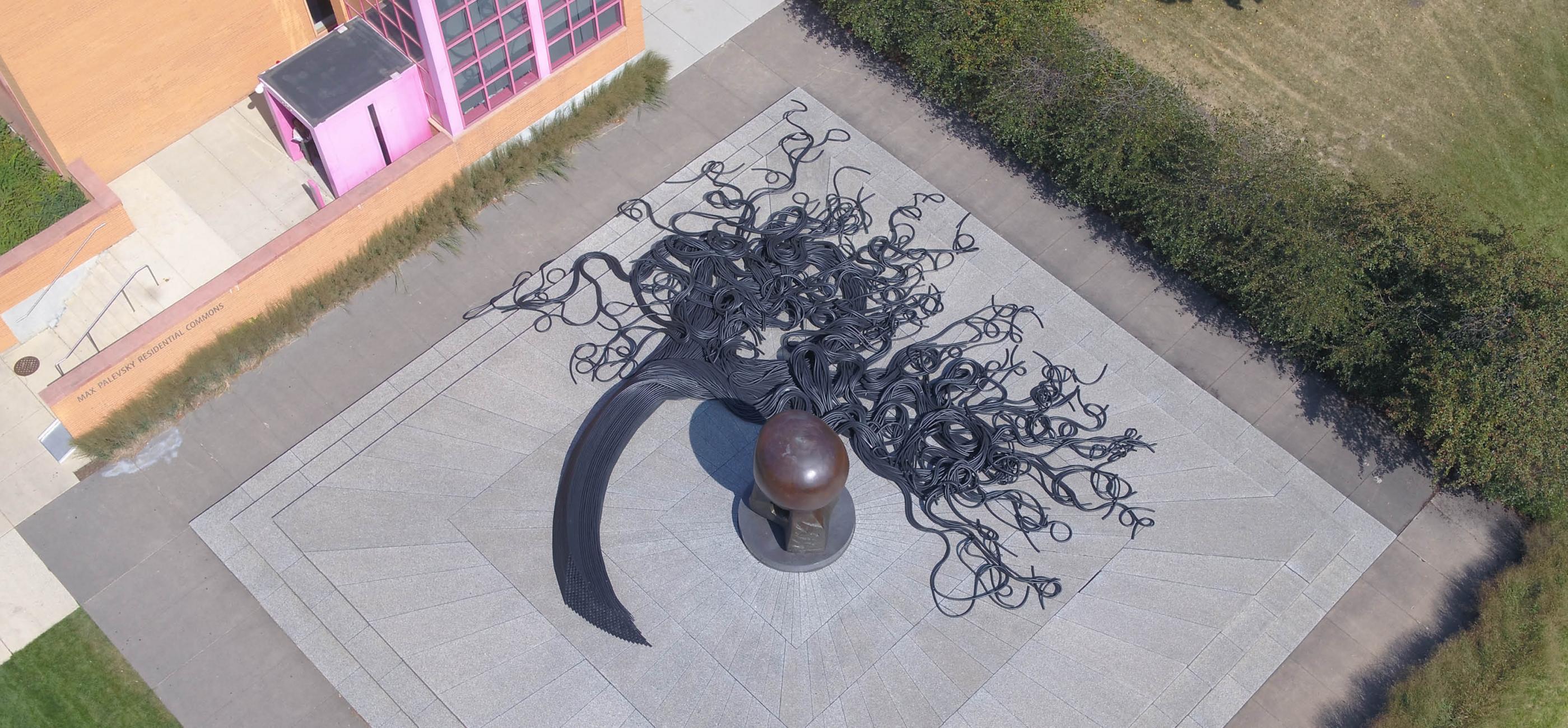
Nuclear Thresholds, an architectural installation at the site of Moore’s sculpture, runs through January 7, 2018. (Photography by Drone Media Chicago)
The subject of controversy when it was commissioned, Nuclear Energy has become a constant in the UChicago landscape.
This essay is part of the special feature “Core Stories,” which commemorates the 75th anniversary of the first controlled, self-sustaining nuclear chain reaction.
Henry Moore’s sculpture Nuclear Energy, which turns 50 in December, marks the site of the world’s first controlled, self-sustaining nuclear reaction. Just as Enrico Fermi’s achievement can never be decisively celebrated nor indicted, ambiguities and paradoxes are embedded in the form, origins, title, and interpretations of the artwork made to commemorate it.
An object that appears unitary but is actually composed of some 60 pieces of welded bronze, Nuclear Energy presents both mass and emptiness, solid and void. The sculpture is a monumental object that commemorates a microscopic reaction—invisibly small particles set in motion by a 400-ton pile of graphite bricks. And there remain contradictions in the origin story of the sculpture’s form. Was it based on a series Moore made a decade before the commission? On contemporaneous British anti-nuclear posters that featured a mushroom cloud and a human skull? On an elephant skull Moore had himself photographed with, working on the Nuclear Energy model, years after the sculpture was completed?
The idea for a landmark was born in 1963, as history professor William H. McNeill, LAB’34, AB’38, AM’39, on the way to his office, passed the weed-strewn lot on Ellis Avenue that once was the site of Stagg Field—and Chicago Pile-1. McNeill’s sense of the site as a lost opportunity echoed the sentiments, according to various accounts, of the University’s public relations office, president, and even the Italian prime minister at the time, who felt that Fermi and the University’s role in the Manhattan Project had not been adequately recognized. A committee, spearheaded by McNeill, was formed to investigate the possibility of erecting a memorial in time for the 25th anniversary of the nuclear reaction.
In November 1963 McNeill sent letters to two contemporary sculptors known for their public works, Jacques Lipchitz and Henry Moore. Moore, considered a “safe modernist master” according to one social historian, despite his own antinuclear stance, offered a tentative yes. In a year he had produced a four-foot-tall model, called Atom Piece, of what would become Nuclear Energy: a cavern or, as McNeill liked to call it, a “cathedral” surrounded by an armature of bronze. Others, particularly several scientists on the monument committee, saw the work as a skull or mushroom cloud—“more appropriate … at Alamogordo or Hiroshima,” in the words of Samuel Allison, SB’21, PhD’23, one of the Manhattan Project scientists on the committee—and objected strenuously to Moore’s model.
The sculpture was ultimately approved, but concessions were made to soften its more fatalistic interpretations, including installing a carefully worded plaque with it and asking Moore in 1965 to change his title, Atom Piece, to Nuclear Energy because McNeill felt the former sounded too much like “atom peace,” a potentially inflammatory pun. Moore publicly agreed to the title change but continued to call the work “Atom Piece,” even exhibiting it in Germany under that title before it arrived in Chicago to be unveiled on December 2, 1967, the 25th anniversary of the reaction.
At that unveiling, Harold Haydon, LAB’26, PhB’30, AM’31—associate professor of art, art critic for the Chicago Sun-Times, and member of the monument committee—spoke of Nuclear Energy in the future tense: “Nuclear energy, for which the sculpture is named, is a magnet for conflicting emotions, some of which inevitably will attach to the bronze form; it will harbor or repel emotions. … The test of any work of art will be its capacity to evoke a response and the quality of that response.” As Haydon well knew, Nuclear Energy had already passed that test.
Erin Hogan, AM’91, PhD’99, is the former director of public affairs and communications at the Art Institute of Chicago and the author of Spiral Jetta: A Road Trip through the Land Art of the American West (University of Chicago Press, 2008).
